How do I use ATRS to export Tableau Reports to Excel?
Export Tableau reports to Excel & automatically deliver them to an FTP site, send them in emails, or deliver them to any number of other destinations. ATRS lets you customize them before delivery. Here's how.
- This article describes how to export Tableau Reports to the following formats:
- MS Excel - Data Only (*.xlsx)
- MS Excel (*.xlsx)
Excel options requires that you have MS Office 2000 or above installed and you have applied the very latest service pack for your version of MS Office.
MS Excel - Data Only (*.xlsx) outputs for Tableau Reports
Step 1: Select MS Excel - Data Only from the drop down
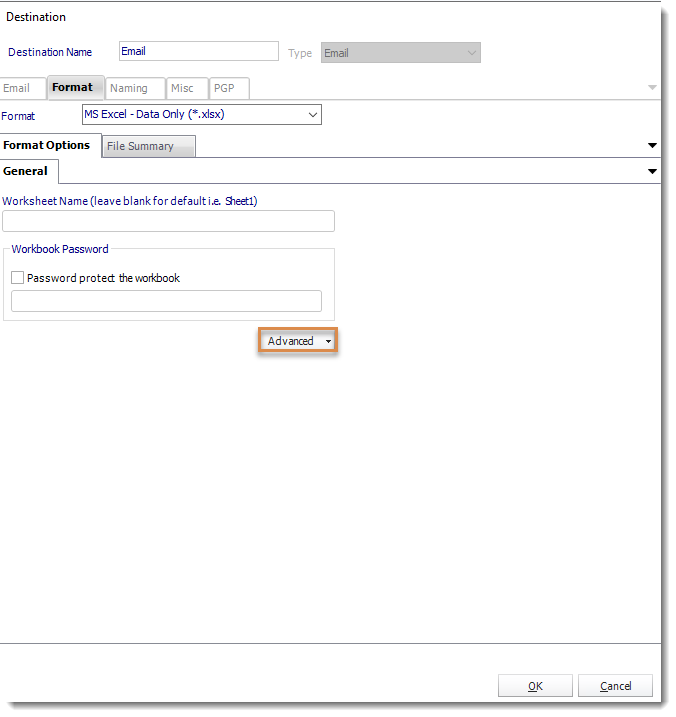
Step 3: If you need to password protect the workbook, enter a password in tis field, This workbook will not be able to be accessed without a password.
Step 4: For MS Excel Data Only (*.xlsx), additional formatting options are available, including the ability to add Column and Row Totals using Excel Templates. To explore these features, simply click on the Advanced option within the Format Options tab.
Step 5 (optional): Use these General settings if you wish to Add Row Totals in that visual worksheet. This option will add row totals in all rows of the visual. or to add column totals in that visual worksheet. This option will add column totals in all columns of the visual or you may choose to Only summarize the following rows/columns (comma delimited): If you don't want to add all rows/columns total in the visual worksheet, enter the number of the row/column where you want the total of the row/column in the visual worksheet.
You must have checked Add Row/Column Totals to use this option.
Step 6 (optional): Using an Excel Template. Select this option if you want to export the Tableau report to an excel template already created.

Step 7: Once you check Use an Excel template, use the (...) button to browse the excel template.
Step 8: Once the excel template is selected, select the worksheet you want to export the Tableau report.
- You have the option to select the specific column and row for the report or select the next available column and row.
Step 9 (optional): Adding Style to the Exports. You may modify the font-weight and colors of that visual.
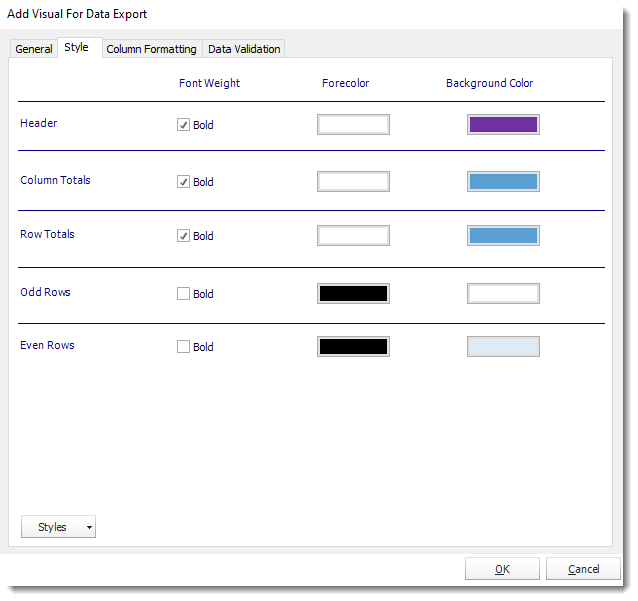
- You can import and/or export styles to be used in other destinations and schedules.
Step 10 (optional): If you need to specify any Column Formatting, you may do that here. Simply Enter the Header Name, select the required Data Type from the Drop down and the Custom Format.
Step 11: Click Add to save the settings

| Format String | Value | Output |
| ### | 123 | 123 |
| 000 | 10 | 010 |
| #,# | 1000 | 1,000 |
| 00.00 | 10.1 | 10.10 |
| #,##0.00 | 1000 | 1,000.00 |
| #0.##% | 0.011 | 11% |
| 0.00% | 0.0123 | 1.23% |
| 0.00E+00 | 120000 | 1.20E+05 |
| #?/? | 1.25 | 1 1/4 |
| #\?/100 | 1.25 | 1 25/100 |
| 0.00_);[Red]\(0.00\) | -1,123 | (1.12) |
| 0.00_);\(0.00\) | -1,123 | (1.12) |
| $#,##0.00 | 5,46 | $5.46 |
| #,##0.00\[$€-1]_);\(#,##0.00\[$€-1]\) | 123 | 123.00€ |
| [$€-2]\#,##0.00_);\([$€-2]\#,##0.00\) | 123 |
€123.000 |
| [$-F800]dddd\, \mmmm\ dd\, \yyyy | 24.2.2020. 0:00:00 |
Monday, February 24, 2020 |
| [$-409]mmmm\d\, \yyyy;@ | 24.2.2020. 0:00:00 |
February 24, 2020 |
| [$-409]d\-mmm;@ | 24.2.2020. 0:00:00 |
24-Feb |
| [$-409]m/d/yy\h:mm\ AM/PM;@ | 24.2.2020. 0:13:00 |
2/24/20 12:13 AM |
| [$409]h:mm\ AM/PM:@ | 24.2.2020 21:10:00 |
9:10 PM |
| @ | abc |
abc |
Step 12 (optional): If you wish to validate your data before the report is sent check Validate date prior to delivery option.

Step 13: Click OK to save the settings.
Step 14: File Summary Determine file summary by filling in the required properties.

If properties are not filled in or are left blank, the original properties which exist in the exported report will be preserved. To overwrite these with a blank, enter a space in the field you wish to overwrite.
Step 15: Naming, these options determine how the exported file will be named:
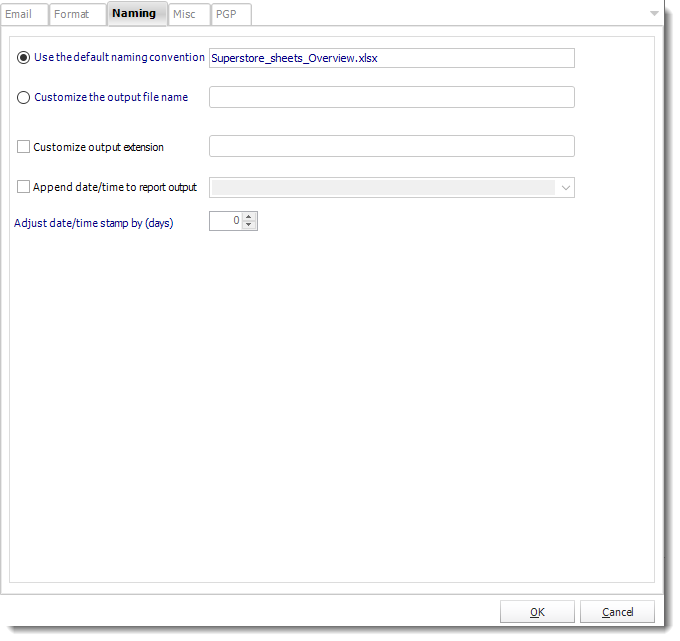
- Default Naming Convention: ATRS will name the output file in the following format: reportname.format extension, e.g. Catalog Report.pdf.
- Customize the output file name: Choose your own filename or right-click and use the Insert Function to insert a value.
- Customize output extension: Choose your own extension. This is useful for system integration. For example, the default extension for a character separated file is "CSV," but you can give your export an extension of "txt" so that the file can be read by another already existing system you may have. You may also right-click and use the Insert Function to insert a value.
- Append date/time: This is useful for the following reasons:
- If the filename is the same each time, and it is being exported to the same folder each time, then it will be overwritten by the latest one each time. By appending date and time to the filename, each file remains unique, and no files are overwritten.
- You can track which reports ran and when they ran by looking at what the report is named.
Step 16: Misc, this section is used for Compress (ZIP) Output, Zip File Encryption and deferring delivery of the export.
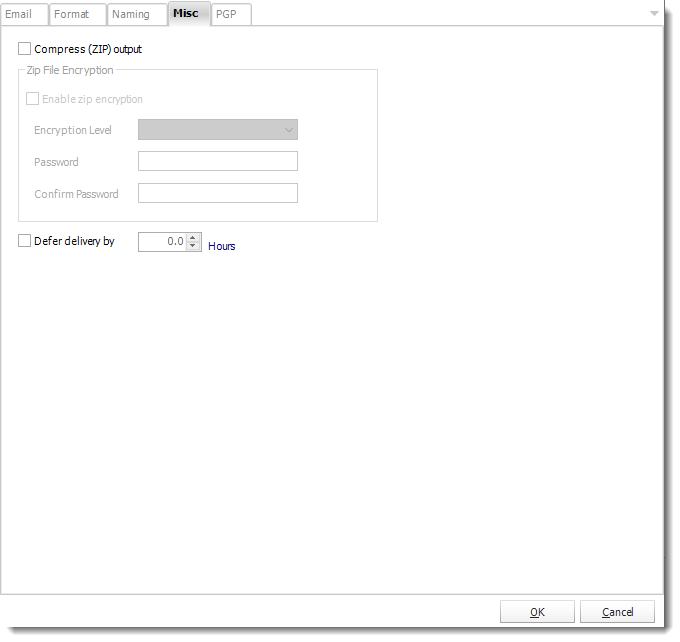
- Compress (ZIP) Output: Zips the output. Ability to use .zip encryption as well.
- Zip File Encryption: Check the option to encrypt and password protect the zip file.
- Defer Delivery: The report will be generated at the scheduled time, but will not be delivered to the specified destination until later.
- For more information, go to Deferred Delivery
Step 17: Check the option to Enables PGP Encryption for better security with your PGP UserID.

MS Excel (*.xlsx) outputs for Tableau Reports
Step 2: If you need to password protect the workbook, enter a password in tis field, This workbook will not be able to be accessed without a password.
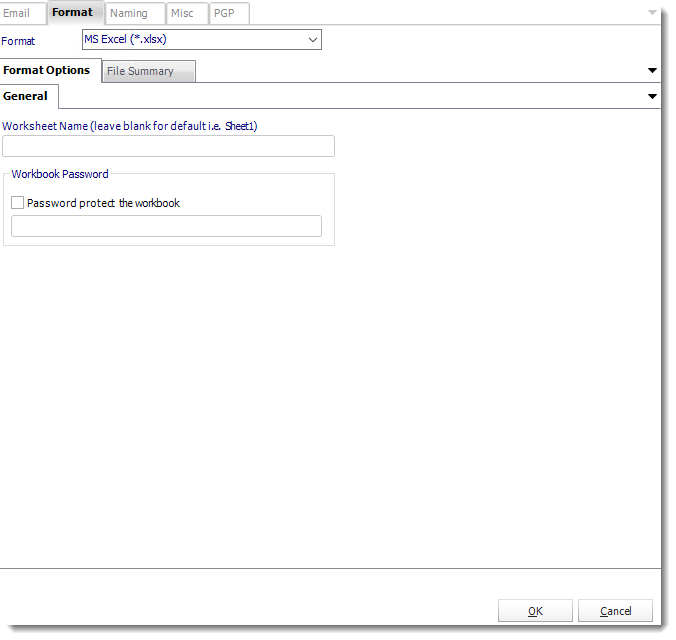
Step 3: File Summary Determine file summary by filling in the required properties.

If properties are not filled in or are left blank, the original properties which exist in the exported report will be preserved. To overwrite these with a blank, enter a space in the field you wish to overwrite.
Step 4: Naming, these options determine how the exported file will be named:

-
- Default Naming Convention: ATRS will name the output file in the following format: reportname.format extension, e.g. Catalog Report.pdf.
- Customize the output file name: Choose your own filename or right-click and use the Insert Function to insert a value.
- Customize output extension: Choose your own extension. This is useful for system integration. For example, the default extension for a character separated file is "CSV," but you can give your export an extension of "txt" so that the file can be read by another already existing system you may have. You may also right-click and use the Insert Function to insert a value.
- Append date/time: This is useful for the following reasons:
- If the filename is the same each time, and it is being exported to the same folder each time, then it will be overwritten by the latest one each time. By appending date and time to the filename, each file remains unique, and no files are overwritten.
- You can track which reports ran and when they ran by looking at what the report is named.
Step 5: Misc, this section is used for Compress (ZIP) Output, Zip File Encryption and

- Compress (ZIP) Output: Zips the output. Ability to use .zip encryption as well.
- Zip File Encryption: Check the option to encrypt and password protect the zip file.
Step 6: Check the option to Enables PGP Encryption for better security with your PGP UserID.
